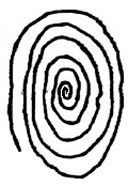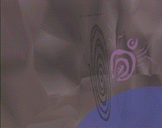Portals
 One of the goals of Placeholder was to experiment with various techniques for representing space, time, and distance. The three environments were separated by several miles of Canadian mountains and forests. We needed a way for participants to move among them without simulating the actual traversal of the intervening landscape. We knew of a few previous experiments in the area, conducted at the NASA Ames Research Laboratory in the mid-80's, that used various permutations of windowing to allow people to move among unconnected spaces, but we were unsatisŽed with the window metaphor, Žnding it too close to the visual language of computers. Our wanderings through cultural anthropology, mythology, and folklore eventually led us to adopt the idea of active Portals that would transport people among the worlds. Our encounters with rock art and aboriginal visual symbols brought us to the spiral as an appropriate sign for the Portal.
One of the goals of Placeholder was to experiment with various techniques for representing space, time, and distance. The three environments were separated by several miles of Canadian mountains and forests. We needed a way for participants to move among them without simulating the actual traversal of the intervening landscape. We knew of a few previous experiments in the area, conducted at the NASA Ames Research Laboratory in the mid-80's, that used various permutations of windowing to allow people to move among unconnected spaces, but we were unsatisŽed with the window metaphor, Žnding it too close to the visual language of computers. Our wanderings through cultural anthropology, mythology, and folklore eventually led us to adopt the idea of active Portals that would transport people among the worlds. Our encounters with rock art and aboriginal visual symbols brought us to the spiral as an appropriate sign for the Portal.
Spider approaching a Portal to transit to another
World.
 |
When a person approached a portal closely,
it emitted ambient sound from the next World to which that person would transport if
they walked into the Portal. Another person
in the same environment would hear these
portal sounds from a distance, but upon closer
approach to the portal, might hear the sound
of another environment coming through the
portal, since the destination of each person
was determined individually by random choice.
Within the Portal, time was compressed but
not absent - the duration of a transit was
about 10 seconds, in darkness, accompanied
by an iconic set of sounds for the World they were in transit to -
Cave transit sounds,
Hoodoos transit sounds, and
Waterfall transit sounds.
People were able to see two glowing points
of light representing the "grip" of each
hand (if they happened to raise their hands
to within their Želd of view), and some people
seemed to use these points of light to orient
themselves and maintain their balance. Many
questions remain about the duration of the
interval (people might be too disoriented
by instant teleportation, but was the transit
too long?) and the visual effects of the
transit (would a neutral color with the suggestion
of a flowŽeld better represent this metaphorical
movement through space?).
Upon their initial entry to Placeholder in the
Cave World, mere humans were invisible, to themselves (save for the points of light on the hands), and to each other. They couldn't use the Portals or see the Voiceholders. All they could do was talk and explore the immediate environment of the Cave World. From the moment people entered the world the
Critters were talking to them, bragging about their qualities and enticing people to "come closer." When a person's head intersected one of the
Critters, he or she became "embodied" as that
Critter. The
Critter, now functioning as a
"smart costume", changed how a person looked, sounded, moved, and perceived the world. From then on, they could interact with Voiceholder, and they could transit to the other three Worlds through the Portals.
Placeholder
Papers
 Movies
Movies
 Sounds
Sounds
 Images
Images
 One of the goals of Placeholder was to experiment with various techniques for representing space, time, and distance. The three environments were separated by several miles of Canadian mountains and forests. We needed a way for participants to move among them without simulating the actual traversal of the intervening landscape. We knew of a few previous experiments in the area, conducted at the NASA Ames Research Laboratory in the mid-80's, that used various permutations of windowing to allow people to move among unconnected spaces, but we were unsatisŽed with the window metaphor, Žnding it too close to the visual language of computers. Our wanderings through cultural anthropology, mythology, and folklore eventually led us to adopt the idea of active Portals that would transport people among the worlds. Our encounters with rock art and aboriginal visual symbols brought us to the spiral as an appropriate sign for the Portal.
One of the goals of Placeholder was to experiment with various techniques for representing space, time, and distance. The three environments were separated by several miles of Canadian mountains and forests. We needed a way for participants to move among them without simulating the actual traversal of the intervening landscape. We knew of a few previous experiments in the area, conducted at the NASA Ames Research Laboratory in the mid-80's, that used various permutations of windowing to allow people to move among unconnected spaces, but we were unsatisŽed with the window metaphor, Žnding it too close to the visual language of computers. Our wanderings through cultural anthropology, mythology, and folklore eventually led us to adopt the idea of active Portals that would transport people among the worlds. Our encounters with rock art and aboriginal visual symbols brought us to the spiral as an appropriate sign for the Portal.
